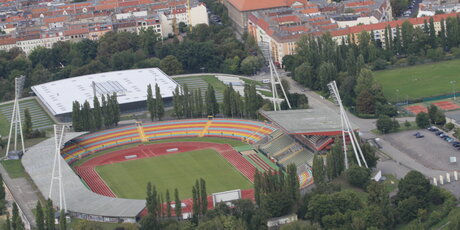Friedrich-Ludwig-Jahn-Sportpark
To the community he was called the “Exer”. Since 1825 the sports park was used as a military exercise field for the Prussian army. Its landmark was the “Lonely Cottonwood tree”.
In March 1848 the first council meeting during the 1848 revolution was held near the cottonwood tree in front of the Schönhauser gate. Up to 20.000 people demanded from Friedrich Wilhelm IV (1765-1861; 1840-1857 the Prussian king) that there be general elections, 12 hour working day, minimum wage and the people upbringing should be in the hands of the state and not from private or religious schools. The “Lonely cottonwood tree” was cut down in 1968 on Topsstrasse. Today in its place stands an Aspen tree from the plantation of black Aspen trees in Dresden. At the end of the 19 hundreds the army redeveloped the “Exer” as a training field so the park could be used by sportsmen and women. Also till 1904 it was the first football ground for Hertha BSC. The Berlin football club was founded in a local pub close to Zionskirchstrasse called “Hertha 92”. Today though the home stadium of Hertha BSC is now the Olympic stadium situated in Charlottenburg. In 1912 the city of Berlin bought a large part of the land and loaned it out in 1913 to be used for sports activities and for athletes to train on. On the occasion of the world youth festival and games in 1951 the area was rebuilt into a sports park. On 22 hectares there was a football and athletics stadium with a capacity of 20,000 with more training and tournaments pitches. In 1952 the East Berlin magistrate named the sports park after Friedrich Ludwig Jahn (1778-1852) also known as the “Father of gymnastics”. The Max-Schmeling-Halle was built on the North side of the sports park in attempt to host the 2000 Olympics. In 2015 the Final of the UEFA Women’s Champions League took place here and in 2018 theEuropean para Athletics Championships.
© Apercu Verlag
